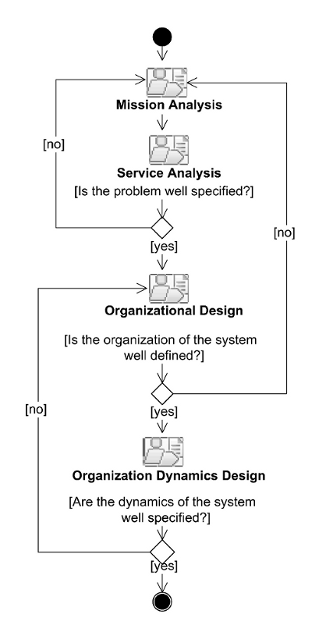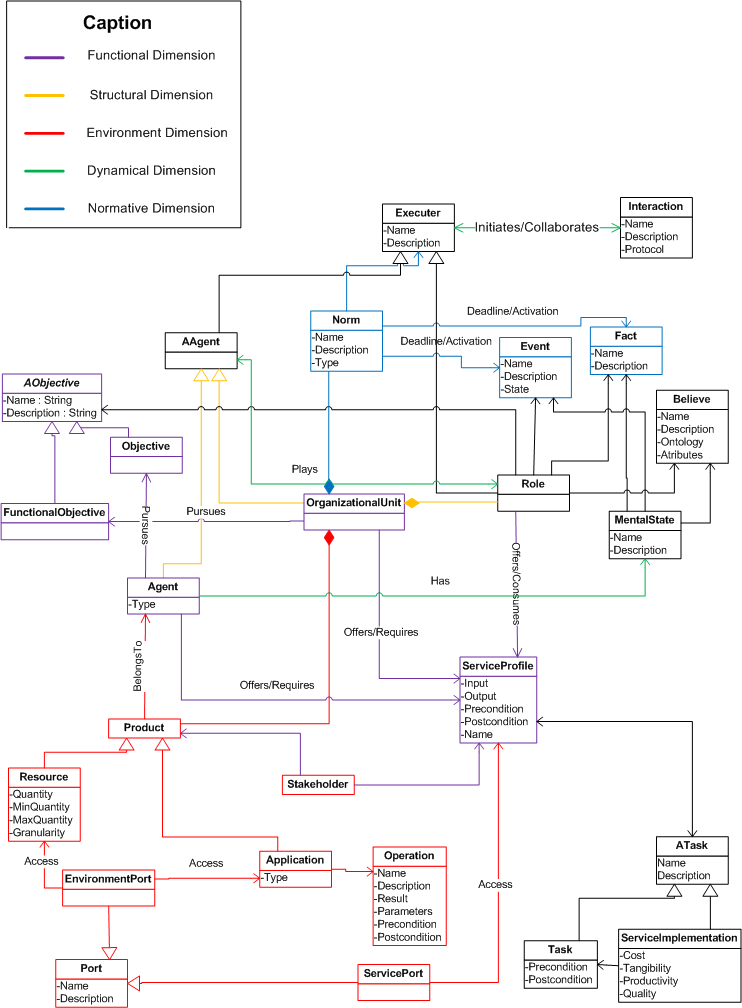GORMAS (Guidelines for ORganizational Multi-Agent Systems) defines a set of activities for the analysis and design of Virtual Organizations, including the design of their organizational structure and their dynamics. With this method, all services offered and required by the Virtual Organization are clearly defined, as well as its internal structure and the norms that govern its behavior.
GORMAS is based on a specific method for designing human
organizations, which consists of diverse phases for analysis and design. These
phases have been appropriately adapted to the MAS field, this way to catch all
the requirements of the design of an organization from the agents' perspective.
Thus, the methodological guidelines proposed in GORMAS
cover the typical
requirement analysis, architectural and detailed designs of many relevant
Organization-Centered Multi-Agent Systems (OCMAS) such as PASSI, SODA, AGR,
INGENIAS... methodologies, but it also includes a deeper analysis of the system
as an open organization that provides and offers services to its environment.
This methodology is specified in order to design large scale, open and service-oriented MAS, where organizations are able to accept external agents into them. In order to model this kind of systems, GORMAS is supported by a CASE tool named EMFGormas, that uses the MDA Eclipse Technology. This technology requires defining a platform independent unified meta-model that describes the modeling language in a formal way, establishing the primitives and syntactic-semantic properties of organizations and multi-agent system. The tool offers several graphical editors, one for each view of the model, but diagrams are saved in a unique model.
GORMAS is composed of four phases, covering the analysis and design of a MAS: first activity is mission analysis, a phase that implies the analysis of the system requirements, the use cases, the stakeholders and the global goals of the system; the service analysis phase specifies the services ofered by the organization to its clients, as well as its behavior, and the relationships between these services; the organizational design step define the structure for the Virtual Organization, establishing the relationships and restrictions that exist in the system; and finally, at the organization dynamics design step, communicative processes between agents are established, as well as processes that control the acquisition of roles along with processes that enable controlling the flow of agents entering and leaving the organization. Additionally, some mechanisms (norms) that are used to control the system are defined. Finally, the organization dynamics design step is responsible of designing guides that establishing a suitable reward system for the organization.

GORMAS metamodel takes into account the main aspects of a Virtual Organization: (i) the Structural Dimension, describing the components of the system and their relationships; (ii) the Functional Dimension, detailing the specific functionality of the system, based on services, tasks and goals, as well as system interactions, activated by means of goals or service usage; (iii) the Dynamical Dimension, which details the dynamic enactment of roles by agents, their dynamic participation into units and their interactions; (iv) the Environmental Dimension, describing the environment in terms of its resources and how agents can perceive and act on them; (v) Normative Dimension, defining the organizational norms and normative goals that agents must follow, including sanctions and rewards. All of this five dimensions are represented at the GORMAS metamodel by a model.
